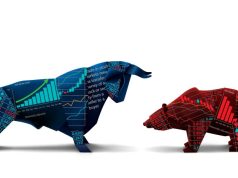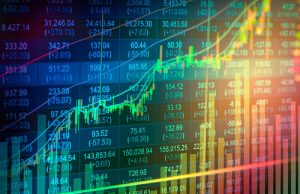The Income Oasis: Stable Dividend Stocks for Market Sell-Offs
In the wake of Tuesday’s market sell-off, investors are left pondering whether this downturn signals the onset of a more significant market correction. Amid such uncertainty, there’s a strategic approach to not only safeguard your portfolio but also to continue generating income during these turbulent times.
The recent dip saw the three major indexes each tumble by over 1%, a notable deviation from the robust first quarter that witnessed the S&P 500 reaching new record highs in nearly 40% of trading days, as highlighted by Bespoke Investment Group. This shift underscores the market’s sensitivity to economic indicators, which, while suggesting enduring economic strength, introduce a layer of unpredictability regarding future Federal Reserve actions on interest rates. According to Larry Tentarelli, founder of the Blue Chip Daily Trend Report, while a strong economy bodes well for stocks in the long haul, it can also lead to short-term market volatility due to the added uncertainty.
Given these dynamics, investors might consider turning to dividend-paying stocks as a defensive maneuver to mitigate portfolio risk while still securing a steady income stream. Our focus shifts to identifying stocks that not only weathered Tuesday’s downturn but also exhibit less volatility than the broader market—a beta of less than 0.9—and offer a dividend yield of over 1%. Additionally, we sought out stocks with an average Wall Street analyst price target suggesting an upside potential of 5% or more. This curated watchlist aims to spotlight defensive assets that promise both stability and income, making them worthy of consideration during sell-offs or periods of heightened market volatility.
Verizon Communications Inc. (NYSE: VZ) – A Strong Performer with Upside Potential
In the early months of 2024, Verizon has already made a notable mark, climbing more than 12% and outperforming the S&P 500. This surge reflects investor confidence and the company’s solid fundamentals, underscored by its strong finish in 2023. With wireless service revenue reaching $76.7 billion, up 3.2% from the previous year, and significant increases in both fixed wireless and total wireless postpaid net additions, Verizon’s strategic growth initiatives are paying off. The company’s operational strength, highlighted by a year-over-year surge in fixed wireless net additions of over 31% and a spike in total wireless postpaid net additions by 26%, showcases its ability to attract and retain customers effectively.
Despite facing a slight dip in total operating revenue for the full year and a consolidated net loss in Q4 2023 due to special items, Verizon’s financial health remains robust. The company reported a full-year cash flow from operations of $37.5 billion and a free cash flow of $18.7 billion, indicating strong operational efficiency and financial flexibility.
The outlook for 2024 remains positive, with Verizon projecting total wireless service revenue growth of 2.0% to 3.5% and an adjusted EPS range of $4.50 to $4.70. These forecasts, along with ongoing investments in network and service enhancements, position Verizon for continued growth.
Analysts are closely watching Verizon, with opinions divided between buy and hold ratings. However, the consensus points to further upside, with an average price target suggesting more than 5% growth potential. Additionally, Verizon’s attractive 6% dividend yield adds a layer of income generation for investors, making it an even more appealing option for those seeking both growth and income.
Given its strong performance thus far in 2024, solid fundamentals, and the potential for further gains backed by a healthy dividend, Verizon (VZ) stands out as a compelling investment. Investors are advised to consider adding Verizon to their watchlist or portfolio, especially those looking for a blend of growth, income, and resilience in the face of market volatility.
Sempra (NYSE: SRE) – Poised for Growth Amid Analyst Optimism
Despite a slight downturn of nearly 4% in its stock price so far this year, Sempra stands out in the utility sector with analysts forecasting a bright future. The consensus among experts suggests a potential upside of more than 15% over the next twelve months. With three-quarters of analysts surveyed by LSEG rating Sempra as a buy or strong buy, the company’s prospects look promising for investors seeking growth opportunities.
A pivotal development in 2023 was the announcement of a 20% increase in Sempra’s capital plan, now standing at $48 billion. This ambitious expansion underscores the company’s commitment to enhancing energy infrastructure across North America, with a particular focus on Sempra California and Sempra Texas. These regions are witnessing a surge in demand for safer, more reliable, and cleaner energy solutions. Furthermore, the company’s decision to raise its annualized common stock dividend for the 14th consecutive year highlights its dedication to shareholder value.
Looking forward, Sempra has narrowed its full-year 2024 EPS guidance to a range of $4.60 to $4.90 and set a full-year 2025 EPS target of $4.90 to $5.25. This forward-looking stance reaffirms the company’s anticipated long-term EPS growth rate of approximately 6% to 8%, reflecting confidence in its strategic direction and profitability.
Given the combination of Sempra’s solid financial achievements in 2023, its strategic capital investments, and the optimistic outlook shared by analysts, the company represents a compelling investment opportunity. Sempra’s focus on sustainable growth, backed by a robust dividend policy and significant capital expenditures, positions it as a key player in the evolving energy sector, poised for substantial growth. Investors are encouraged to consider Sempra for their portfolios, leveraging the anticipated upside potential and the company’s strategic initiatives aimed at long-term value creation.
Darden Restaurants (DRI) – A Pick with Appetizing Dividends
Darden Restaurants, the powerhouse behind some of your favorite dining spots, is serving up more than just delicious meals; it’s dishing out a 3.3% 12-month forward dividend yield that’s sure to catch the eye of dividend hunters. With the stock up 4.5% this year and a nearly 19% increase in 2023, Darden is proving to be a resilient player in the volatile restaurant industry.
Analysts give Darden an overweight rating, seeing a modest but solid 4% upside to the average price target. This optimism is not unfounded. The company is on the brink of revealing its fiscal third-quarter financial results next week, riding high on the back of fiscal second-quarter earnings that exceeded expectations. While revenue didn’t quite hit the mark last quarter, Darden’s decision to raise its full-year earnings guidance signals a confident outlook on its financial health and operational efficiency.
Let’s not forget the cherry on top: in June, Darden turned up the heat on its shareholder returns, increasing its dividend by 8% to $1.31 per share. This move is more than just a number adjustment; it’s a testament to Darden’s commitment to rewarding its investors and its belief in the company’s continued growth.
For those looking to spice up their investment portfolio with a stock that combines a robust dividend yield with potential for capital appreciation, Darden Restaurants offers a compelling blend of stability and growth prospects. As we await the latest earnings report, Darden stands out as a flavorful pick in the high-quality dividend stock menu.














